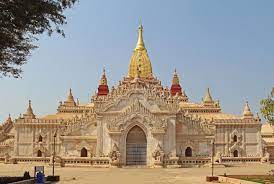Ananda Buddhist Temple- Myanmar (Burma)

Address
Ananda Buddhist Temple- Old Bagan, Myanmar (Burma)
Deity
Buddha
Introduction
- Location: Bagan, Myanmar.
- Religion: Buddhist.
- Built: 1105 AD during the reign of King Kyansittha of the Pagan Dynasty.
- Architecture: Cruciform layout with terraces leading to a small pagoda topped by an umbrella (hti).
- Buddhas: The temple houses four standing Buddhas facing each cardinal direction (East, North, West, South).
- Style: Fusion of Mon and Indian architectural styles.
- Nickname: Known as the “Westminster Abbey of Burma.”
- Damage & Restoration: Damaged in the 1975 earthquake but fully restored and well-maintained.
- Anniversary: Spires gilded in 1990 during the 900th anniversary of its construction.
Puranic Significance
- History: Credited to King Kyansittha, marking the transition from Early to Middle Bagan period.
- Name Origin:
- Named after Venerable Ananda, Buddha’s cousin and devoted attendant.
- Once known as Ananta Temple, derived from Sanskrit “ananta pinya” (endless wisdom).
- “Ananda” in Pali and Sanskrit means “bliss.”
- Legend:
- Eight monks described the Nandamula Cave in the Himalayas to King Kyansittha.
- Pleased with their skills, the king asked them to build a temple with cool conditions.
- After completion, the king had the monks killed to ensure the uniqueness of the temple.
Special Features
- Temple Structure:
- Simple corridor layout with a central square of 53 meters.
- Four gabled porches project 57 feet from the square.
- The temple’s terraces lead to a pagoda topped with an hti (umbrella ornament).
- Buddha Statues:
- Four standing Buddhas, each 9.5 meters tall, made of solid teak wood.
- Each faces a cardinal direction:
- Kassapa (South-facing).
- Kakusandha (North-facing).
- Konagamana (East-facing).
- Gautama (West-facing).
- South and North Buddhas are original, while East and West are replacements.
- Plaques:
- Glazed terra-cotta tiles depicting Jataka tales (Buddhist stories) line the temple’s walls and terraces.
- Stone Sculptures:
- 1500 stone images inside the temple, though many are worn and unclear.
Festivals
- Annual Festival: Held for a week during Pyahto (December–January).
- Monk Participation: 1000 monks chant scriptures for 72 hours.
- Villager Involvement: Thousands of villagers set up encampments around the temple.
- Full Moon Offering: On the full moon day, villagers offer gift bowls to the monks.
Century/Period/Age
1105 AD
Managed By
Department of Archaeology, UNESCO World Heritage Centre.
Nearest Bus Station
Bagan
Nearest Railway Station
Bagan Station
Nearest Airport
Nyaung-U (NYU)




